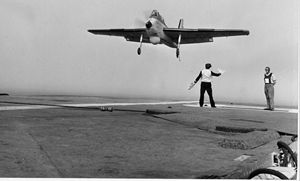Catalogue number 24006
The batsman at work, 1955
Landing on was assisted by a landing signal officer or batsman who would use hand signals to guide the pilot for the right angle and height of approach and alignment onto the deck. Whilst approach speeds remained low, the manual control of deck landing was possible but with the coming into service of jet aircraft, a rapid and automatic system became necessary. Here a Short SB6 Seamew XA213 is landing on H.M.S. Bulwark in 1955, the tail hook is down and we can see the arresting wire in the left foreground.
Verso: “Short Brothers & Harland Limited, Queens Island, Belfast. 1 AUG 1955 Photographic Dept.” blue ink stamp.
21.2cm x 15.7cm Gelatin silver print
|
 |